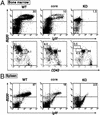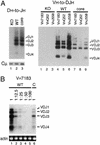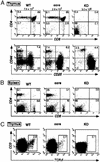Deletion of the RAG2 C terminus leads to impaired lymphoid development in mice
- PMID: 12531919
- PMCID: PMC298752
- DOI: 10.1073/pnas.0237043100
Deletion of the RAG2 C terminus leads to impaired lymphoid development in mice
Abstract
The recombination-activating gene (RAG)1 and RAG2 proteins comprise the lymphocyte-specific components of the V(D)J recombinase and are required for the assembly of antigen-receptor variable-region genes. A mutant truncated RAG2 protein ("core" RAG2) lacking the C-terminal 144 amino acids, together with core RAG1, is able to mediate the basic biochemical steps required for V(D)J recombination in vitro and in transfected cell lines. Here we examine the effect of replacing the endogenous RAG2 locus in mice with core RAG2. These mice generate substantial numbers of B and T cells, demonstrating that the core RAG2 protein retains significant in vivo function. However, core RAG2 mice display a reduction in the total number of B and T cells, reflecting impaired lymphocyte development at the progenitor stage associated with reduced chromosomal V(D)J recombination. We discuss potential roles of the RAG2 C terminus in mediating rearrangement of endogenous antigen-receptor loci.
Figures





References
Publication types
MeSH terms
Substances
Grants and funding
LinkOut - more resources
Full Text Sources
Molecular Biology Databases

